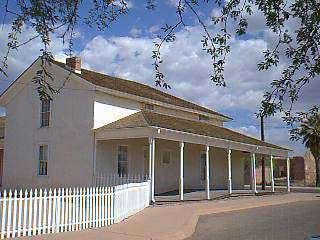
[Source: Arizona State Parks] — Pinal County’s first courthouse, built in 1878, has been slowly deteriorating since 2001 while Arizona State Parks has saved Heritage Fund monies to get the building repaired. Today all the buildings at the park closed in anticipation of the re-opening to the public. Structural stabilization of the historic adobe foundation had been slated for completion in 2009. “Unfortunately in recent years, the structural damage from rain has been so bad that we had to close the historic courthouse last October and staff started dismantling the exhibits in preparation of the renovations,” explained Chief of Operations, Janet Hawks. “We have been saving funds in the account so that we could finally repair the rock foundation, wide cracks in the adobe walls, crumbling wood porch, add support beams, and grade the site to prevent further destruction. The deterioration of the foundation poses a threat to the building. We sent bids for construction out last fall, but now everything is on hold until after our February 20th Board meeting,” she said.
Governor Ernest McFarland bought the Courthouse in 1974 and donated it to the State Parks department. Another facility behind the Courthouse was built later as a repository for his personal papers. In 1976 the state legislature did not allocate operating funds so the new Park’s opening date was pushed back. It wasn’t until March of 1977, during Arizona’s 20th anniversary, that McFarland State Park was opened to the public and later dedicated by Governor Bruce Babbitt.
For 32 years tourists and busloads of children have toured this State Park to experience Arizona’s history and learn how territorial justice was served. They also were taught about Florence’s World War II POW camps and about one of Arizona’s visionary’s, Governor McFarland, who created the State Parks system 52 years ago. Interpretive tours of the park feature the courtroom and judge’s chambers, the sheriff’s office, and the jail. The second story was used as a jury room and quarters for visiting lawmen. Most of the courthouses’ artifacts were moved out just recently, including McFarland’s personal papers. The papers will be transferred to the Arizona Library and Archives’ new state-of-the-art building in Phoenix where researchers will be able to more readily access them. The park staff, who have been preparing for the renovation, will be reassigned to other parks.
A new interpretive plan will be introduced once the stabilization is completed. The focus for the new exhibits in the Courthouse will feature Arizona’s Territorial history and law and order. The 1882 jail will be reproduced within the courthouse building. New updated exhibits about Governor “Mac” McFarland and the World War II Florence POW camp will be displayed in the renovated museum and archives buildings.
